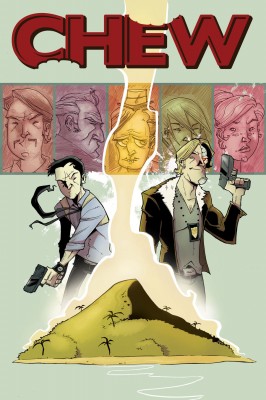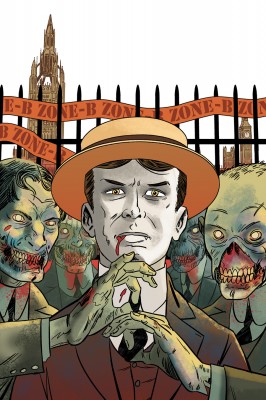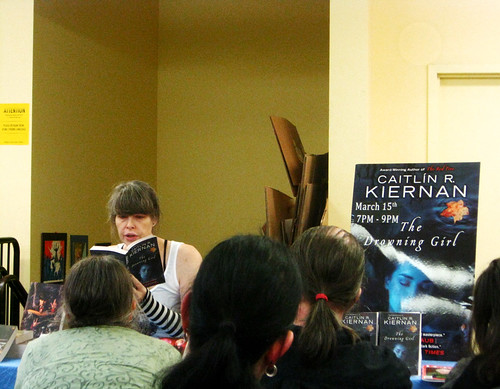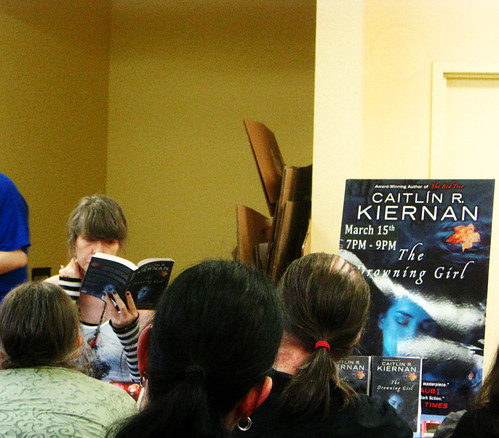Reviewer: Emera
Dates read: Various dates between November 2010 and spring 2011
Books from: Personal collection, or borrowed from Kakaner

Reviewed here be:
Chew, Volume 1: Taster’s Choice (2009)
Chew, Volume 2: International Flavor (2010)
Chew, Volume 3: Just Desserts (2010)
Chew is the story of Tony Chu, a humorless detective who has the unfortunate ability to gain psychic impressions from anything he eats (except beets). Recruited by the FDA – now the world’s most powerful law enforcement agency in the wake of an avian flu pandemic that took hundreds of millions of lives – for his singular talent, Tony finds himself taking bites of stranger and stranger substances as his casework, increasingly muddied by connections to shadowy criminal organizations and possibly extraterrestrial conspiracies, takes him from New York chicken speakeasies to Siberian research stations staffed by vampire ladies in ushankas to tropical dictator states. Add in a generously embarrassing family, an exhaustingly cheerful cyborg partner, and a hate-filled boss, and life just won’t let up on this by-the-rules cop.
Man, this series. I had no idea what I was in for when Kakaner eagerly gifted me the first two volumes, but it proved to be a delicious combination of hyperkinetic art and zany-bordering-on-surreal world-building. Layman and Guillory are an inimitably weird team: to match Layman’s tireless inventiveness (one of the best parts of reading is trying to predict what absurd food-related superpower will next come into play), Guillory’s art is full of odd angles and wildly energetic gestures and the most! excellent! facial expressions, thanks to his characters’ crinkly, mobile features. His backgrounds, too, are stuffed to bursting with silly details (inexplicable graffiti, stray notes and photographs, etc. etc.), and as is only appropriate for an obsessively food-themed series, the distinctive color palette always reminds me of citrus popsicles:

(Even when Tony is getting a barf facial, apparently.)
The plot is obviously going somewhere, but frankly I’ve been so distracted and entertained and perplexed by the moment-to-moment madness of each volume that I haven’t been working all that hard to piece the bits together – though the gathering momentum was obvious by the end of volume 3, and left me hoping for some interesting developments IN SPACE.
I also have to single out Chew‘s creators for the fact that even though they make merry with pulp/genre stereotypes (well hello, melon-breasted Asian lady assassin, nice to roll my eyes at you again) and just-plain stereotypes (the female assassin is exaggerated to clearly satirical proportions; I’m far less comfortable with the fact that the only recurring black character in the series is, straighforwardly, a cowardly criminal), having gone for the Chew/Chu pun, Layman and Guillory obviously committed thereafter to representation of a varied cast of Asian characters. In other words, they didn’t let Tony’s ethnicity stay a one-off joke and then pat themselves on the back for being inclusive by way of one nonwhite protagonist. Which, frankly, I think plenty of other writers, especially in comics, would have done.
I give them heaping points, of course, for having a cool, competent male Asian protagonist in the first place; discounting of Asian men in pop culture as comical, emasculated etc. (if they’re not ninja/samurai) is a major pet peeve of mine. (I did a count once of the number of female Asian superheroes [ooo, so exotic!!] vs. male once, and the ratio was pretty dismal.) But from there, numerous members of Tony’s family, immediate and extended, have also gotten plenty of pagetime, including his cheerfully self-aggrandizing chef brother and adorable, NASA-employee twin sister.
Though character development takes second seat to conceptual and narrative whimsy in Chew, most of the characters are amply buoyed by the series’ manic energy and humor. It’s refreshing and gratifying to see a broad cast of Asian characters getting the same treatment, and adds immeasurably to my enjoyment of a series that already leaves me grinning at every turn.
Go to:
John Layman: bio and works reviewed






